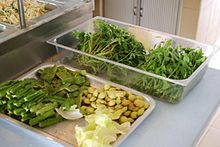Traditional Malay salad
 Raw vegetables for ulam. | |
| Type | Salad |
|---|---|
| Associated cuisine | Indonesia, Malaysia and Singapore |
| Created by | Malays |
| Main ingredients | vegetables |
| Similar dishes | Lalab, Ngapi yay, Nam phrik |
Ulam is a traditional salad produced from the fresh leaves, vegetables or fruits which can be eaten raw or after soaked in hot water e.g. Centella asiatica. It is typically eaten with sauces such as anchovies, cincalok or sambal. It is recognised as a popular vegetable dish in traditional villages.[1][2]
Ulam can be eaten simply as it is such as cucumber, cabbage and longbean. Another type of ulam is traditional ulam, in which it is used more as an ingredient, such as in nasi ulam (ulam rice),[3] nasi kerabu (a type of bluish-coloured rice) and cooking with other vegetables. It also has its uses in Ayurvedic and traditional medicine, such as diabetes and high blood pressure.[citation needed]
See also[edit]
References[edit]
- ^ "Masakan Melayu Riau Khas Pekanbaru" (in Indonesian). 2009. Retrieved September 15, 2020.
- ^ "3 Rekomendasi Resep Masakan Khas Riau untuk Menu Spesial Akhir Pekan" (in Indonesian). 2018. Retrieved September 15, 2020.
- ^ "Nasi ulam". Retrieved 2009-05-07.
Further reading[edit]
- Wan Hassan, W.E. and M. Mahmood.(2010) Ulam: Salad Herbs of Malaysia. Kuala Lumpur: MASBE.
| Common dishes |
| ||||||||||||
|---|---|---|---|---|---|---|---|---|---|---|---|---|---|
| Snacks |
| ||||||||||||
| Desserts | |||||||||||||
| Drinks |
| ||||||||||||
| Condiments | |||||||||||||
Indonesian pickles and salads | |
|---|---|
| Pickles | |
| Salads | |
| Salads |
|
|---|---|
| Bread salads | |
| Dessert salads | |
| Fish salads | |
| Fruit salads | |
| Noodle salads | |
| Related articles | |
Well, that’s interesting to know that Psilotum nudum are known as whisk ferns. Psilotum nudum is the commoner species of the two. While the P. flaccidum is a rare species and is found in the tropical islands. Both the species are usually epiphytic in habit and grow upon tree ferns. These species may also be terrestrial and grow in humus or in the crevices of the rocks.
View the detailed Guide of Psilotum nudum: Detailed Study Of Psilotum Nudum (Whisk Fern), Classification, Anatomy, Reproduction